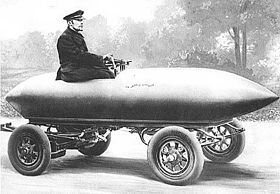La Jamais Contente
| La Jamais Contente | |
|---|---|
 Illustration of "La Jamais Contente", first automobile to reach 100 km/h in 1899 | |
| Overview | |
| Manufacturer | Compagnie Internationale des transports automobiles électriques |
| Also called | The Never Satisfied |
| Production | 1899 |
| Powertrain | |
| Engine | Electrical |
| Dimensions | |
| Length | 3.80 m (12.5 ft)[1] |
| Width | 1.56 m (5 ft 1 in)[1] |
| Height | 1.40 m (4 ft 7 in)[1] |
| Curb weight | 1,450 kg (3,200 lb)[1] |


La Jamais Contente (French pronunciation: [la ʒamɛ kɔ̃tɑ̃t]; English: The Never Contented) was the first road vehicle to go over 100 kilometres per hour (62 mph). It was a Belgian electric vehicle with a light-alloy torpedo-shaped bodywork and batteries. The high position of the driver and the exposed chassis underneath spoiled much of the aerodynamics.[2] The light alloy, called partinium, is a mixture of aluminium, tungsten and magnesium.[3]
The land speed record was established on 29 April or 1 May 1899 at Achères, Yvelines near Paris, France. The vehicle had two Postel-Vinay 25 kW motors, each driving the rear axle via a chain, running at 200 V and drawing 124 A each,[1][4] for about 68 hp total, and was equipped with Michelin tires. The chassis was number 25.
Today, it is on display at the National Car and Tourism Museum in Compiègne.[5]
Driver[edit]
The vehicle was driven by the Belgian driver Camille Jenatzy. Camille was the son of Constant Jenatzy, a manufacturer of rubber products (rubber was still a novelty at the time). Camille had studied as an engineer, with an interest in electric-traction automobiles. He became known for his record-breaking speed runs and was nicknamed Le Diable Rouge ("The Red Devil") for the colour of his beard. He died in 1913, after being shot in a hunting accident.
Motivation[edit]
Wishing to carve a place in the then promising Parisian electric carriage market, Jenatzy started a manufacturing plant, which would produce many electric carriages and trucks. He competed fiercely against the carriage-maker Jeantaud in publicity stunts to see which of them made the fastest vehicles. In order to ensure the triumph of his company, Jenatzy built a bullet-shaped prototype, conceived by the carriage-maker Rothschild in partinium (an alloy of laminated aluminum, tungsten and magnesium).
Speed record[edit]
Jenatzy reached the speed of 105.882 kilometres per hour (65.792 mph), besting the previous record, held by Count Gaston de Chasseloup-Laubat driving a Jeantaud, who had attained 92.78 kilometres per hour (57.65 mph) on 4 March 1899. After this exploit the gasoline-fuelled combustion engine would increasingly supplant electric technology for the next century.
The Jamais Contente is now on display at the automobile museum in Compiègne, France.
See also[edit]
- Other land speed record electric automobiles
- Buckeye Bullet (2004)
- Keio University Eliica (2004)
- Venturi Jamais Contente (2010)
References[edit]
- ^ a b c d e "La Jamais Contente" (PDF). Archived from the original (PDF) on 2006-10-10.
- ^ Wheeling to 800 km/h, Tech Tidbits, May 9, 2005. Archived 2012-10-23 at the Wayback Machine
- ^ Bourgarit, David; Plateau, Jean (2005). "Quand l'aluminium valait de l'or : peut-on reconnaître un aluminium "chimique" d'un aluminium "électrolytique"?". ArchéoSciences (in French). 29 (29): 95–105. doi:10.4000/archeosciences.560. Retrieved 30 August 2011.
- ^ "EV Zero?". EV1 Club. Archived from the original on 2006-10-12. Retrieved 2006-10-18.
- ^ "Musées automobiles : Musée National de la Voiture et du Tourisme (Compiègne) | Moniteur Automobile". www.moniteurautomobile.be (in French). Retrieved 2023-10-12.
This article needs additional citations for verification. (June 2019) |
External links[edit]
- (in French) National car and tourism museum in Compiègne
